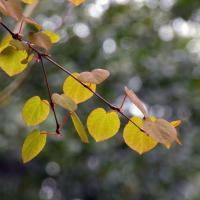 A really local walk today, at least for me. Lister Park is only 10 minutes’ walk from my house, but I haven’t spent much time studying the trees in the botanical gardens. Today’s itinerary was designed to give us time to look at most of the trees here, before moving on to Heaton Woods for a stroll through a more natural woodland.
A really local walk today, at least for me. Lister Park is only 10 minutes’ walk from my house, but I haven’t spent much time studying the trees in the botanical gardens. Today’s itinerary was designed to give us time to look at most of the trees here, before moving on to Heaton Woods for a stroll through a more natural woodland.
With the help of the detailed planting guide in the Council’s Lister Park leaflet, and with Veronica’s expert knowledge, we strolled from the Norman Arch to the top corner of the park over a period of about an hour and a half.
The botanic gardens were first planted in 1904 for the Great Exhibition. The first plan was to demonstrate a range of native flora, but there was local objection to a patch of dandelions (etc.) so the approach was changed and we can see trees and shrubs from around the world. The list includes a couple of splendid Hornbeams, Holm Oak, several Spindles, Corsican Pine (feel free to correct me if I noted this incorrectly), Blue Atlas Cedar, Swamp Cypress, and Katsura Tree. The last couple of notable specimens at the top of the path were the Tulip Tree just coming into leaf, a species that is relic of pre-ice age flora, and the Wellingtonia (or Giant Sequoia) with its soft bark that offers protection from forest fires. There was one tree we couldn’t identify, but Veronica is going to seek advice, so we hope to have an update soon.
I am inspired to make regular return visits to really become familiar with the range of trees, and how they change as the seasons progress. And to see if the Nuthatches are still about.
We crossed Emm Lane and walked along Park Drive into Heaton Woods. We skirted left to climb the path up to Betty’s bench. It was a bit hazy to get the full benefit of a broad panorama over Rombalds Moor etc, but we could make out Shipley Clock Tower, an important local landmark! And our tummies were rumbling so we carried on to our lunch spot at the allotment cabin. Many thanks to Marje who did us proud, providing cakes, tea and coffee somewhere to sit and kindly let us into her flat to use the toilet.
After we had admired her allotment, we set off back into the woods, a set of old steps helping us down the first steep section. The paths are all very dry, very unusual for this time of year. We zigzagged our way through the woods to Red Beck in the valley bottom, joining it at the point where it gets its name; the water running orange with iron deposits. Birds included Blackcap, Blue Tits, Great Tits, more Nuthatches. The ferns are just emerging and we counted 6 species including Board Buckler Fern, Male, Lady, Common Polypody and Hard Fern. In total we recorded 25 species of plant in flower including cuckoo flower and the first Ribwort Plantain that Alice has seen this year. It was evident how the ground flora is absent under the stands of Beech, whereas under the Oak the slopes are carpeted by Great Wood-rush (north facing) and Bluebells (south facing).
The bluebells were at their most advanced as we reached the end of the wood near Redburn Road. At this point we dispersed; some people heading straight home, some to the main road for the bus and some back up the steep Cat Steps to return to the park. This group watched a pair of blue tits popping in and out of a nest box, and, rather less welcomed, a police cordon around the Holm Oak tree where we had been just a couple of hours earlier. They assured us it was nothing to worry about!
I hope people enjoyed taking a closer look at one of our local woods. I never tire of having it on my doorstep, and it is nice to take some time to show it to the BEES group.
See the photos here.
Julia
